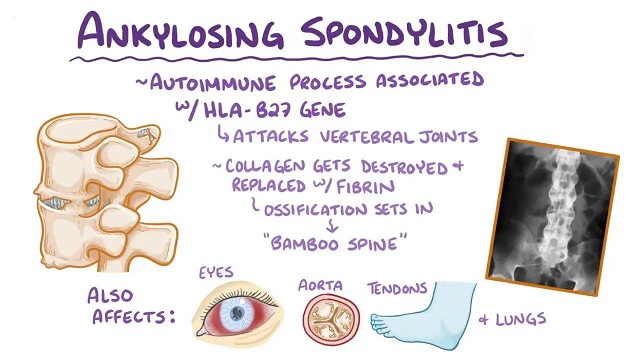Ankylosing spondylitis or ankylosis spondylosis or ankylosis spondylitis is an inflammatory disease of the joints, especially in the joints of the spine. Ankylosing spondylitis is chronic or long-term and is generally experienced by adolescents or young adults.
Symptoms of Ankylosing Spondylitis
Early signs and symptoms of ankylosing spondylitis include pain and stiffness in the lower back and hips in the morning. Pain also occurs when trying to move after a long period of rest. Symptoms may improve or worsen over time.
Here are other symptoms to watch out for:
- Pain and stiffness in the lower back, pelvis, and sitting bones for more than 3 months that is getting worse over time.
- The pain is usually dull and diffuse, making it difficult to pinpoint its exact location.
- Typically, the pain worsens in the morning and evening, then improves with compresses or warm baths or light activity.
- Fusion of the spine from the cervical spine down can make movement difficult.
- Involvement of the sternum can result in difficulty in expanding the chest.
- Pain from bone joints, such as behind the heel of the foot.
- No appetite.
- Feeling tired quickly.
- Pain and redness in the eyes.
- Heart and lung disorders.
Causes of Ankylosing Spondylitis
The exact cause of ankylosing spondylitis is unknown. Most people with the condition have a gene called HLA-B27. This gene triggers the formation of a protein that is linked to the immune system so that it can distinguish between proteins that come from the body itself and from outside, such as viruses or bacteria.
Risk Factors for Ankylosing Spondylitis
The risk of disease increases if a person has a number of the following risk factors:
- Be a teenager or young adult.
- Have a variation of the HLA-B gene type HLA-B27.
- Having parents with a history of ankylosing spondylitis.
- Having a sibling (brother or sister) with this disease.
Diagnosis of Ankylosing Spondylitis
If you experience symptoms, a rheumatologist is a specialist who will diagnose the disease. Rheumatologists are trained and skilled in diagnosing and treating disorders that affect the joints, muscles, tendons, ligaments, connective tissues, and bones. Here are some of the tests performed:
- Physical Examination
A physical examination is performed when the sufferer experiences the following conditions:
- Under 45 years of age.
- Having chronic persistent pain for more than three months.
- Experiencing back pain and stiffness, which worsens with immobility, especially at night and in the morning.
- Experiencing back pain and stiffness, which subsides after physical activity and exercise.
The physical examination aims to find areas of inflammation. Then, the doctor will check for pain and tenderness by pressing along the back, pelvic bone, sacroiliac joints, chest, and heels. The doctor will also check for limitations in spinal mobility in all directions.
- Imaging Test
To check for changes in joints and bones, imaging tests using X-rays will be performed. The examination is followed by an MRI using radio waves and a strong magnetic field to provide more detailed images of bones and soft tissues.
- Laboratory Tests
There is no specific laboratory test to identify ankylosing spondylitis. Certain blood tests can check for inflammation. However, inflammation can be caused by many different health conditions. Blood can be tested for the HLA-B27 gene.
Ankylosing Spondylitis Treatment
Until now, there is no therapy that can completely cure ankylosing spondylitis. The treatment focuses on overcoming the symptoms so that the quality of life of the sufferer can be maintained. Self-treatment is done with therapy or physiotherapy, combined with medication.
In addition to maintaining the quality of life of sufferers, treatment steps are taken with the aim of maintaining normal body posture, so that sufferers can carry out normal daily activities. Common treatment methods include:
- Physical Therapy
Some physical therapies will be assisted by a physiotherapist, such as massage and training to maintain good posture (when sitting, standing, sleeping or walking).
- Sports
One of the recommended sports is swimming.
- Administration of Medication
Medications that can help reduce pain and discomfort in people with this disease include non-steroidal anti-inflammatory drugs, such as aspirin and ibuprofen. Steroids may be needed if indicated.
- Surgery
Surgical therapy to replace joints with artificial joints can help improve ankylosing spondylitis affecting the hip or knee. This way, patients can move more easily or to correct a curved spine.
Complications of Ankylosing Spondylitis
If some symptoms are not treated properly, complications can arise. In severe cases, new bone formation can occur that bridges the gap between the vertebrae. This bone eventually unites the vertebrae, making the area stiff and inflexible.
In addition, here are some complications that could occur:
- Inflammation of the eye or uveitis. This condition is characterized by red eyes, eye pain, decreased sensitivity to light, and blurred vision as well as decreased overall vision function.
- Compression fracture. This condition is characterized by the bone being crushed, but still remaining in its normal position. This will certainly increase the severity of the sufferer’s posture and minimal space for movement.
- Heart problems. This condition is caused by inflammation that distorts the shape of the aortic valve in the heart, disrupting its function. This automatically increases the risk of heart disease.
Prevention of Ankylosing Spondylitis
As a genetic disease, there is actually no specific method to prevent ankylosing spondylitis. However, some efforts can be made to slow the progression of this disease, such as:
- Do not smoke or consume tobacco as it can worsen the condition.
- Sleep on a flat, hard mattress.
- Don’t use pillows that are too high.
- Avoid extreme activities or movements, such as jumping.
- Consume enough calcium to prevent osteoporosis.
- Avoid consuming alcohol.
- Eat vegetables and fruits.
- Reduce consumption of processed foods, especially those containing preservatives and sweeteners.
- Drink enough, at least 2 liters per day.
